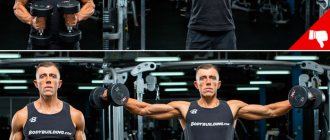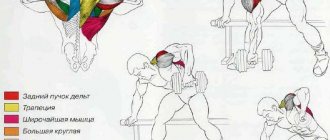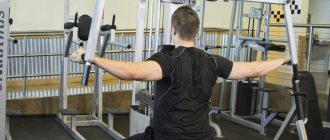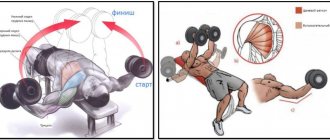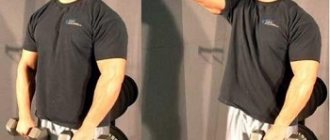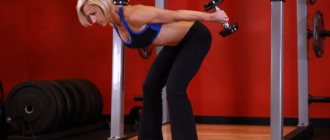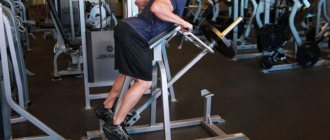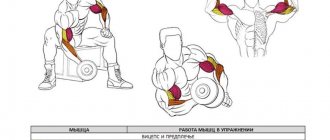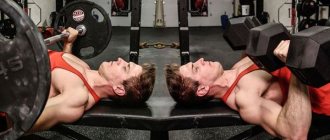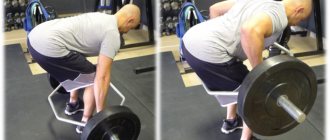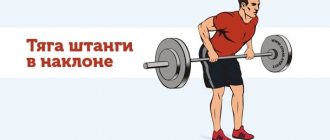The deltoid muscle forms the surface of the shoulder. Its tasks include flexion, extension of the arm, and abduction to the side. Conventional basic shoulder training only targets the anterior and middle bundles of the muscle, with the posterior being statistically the most likely to lag behind. Bent-over dumbbell flyes (swings) will help you use it. If you don't pay attention to the back of the deltoid muscle during exercise, your shoulders will appear disproportionate and your back will appear slouched.
- Purpose of the exercise
- Muscles involved
- Benefits of Exercise
- Options for performing bent over raises
- Standing dumbbell raises
- Video: Bent over dumbbell swings
- Seated dumbbell raises
- Video: Dumbbell flyes for the rear deltoid while sitting on a bench
- Reverse dumbbell flyes lying on an incline bench
- Video: How to pump up your shoulders. Dumbbell flyes lying on a bench
- Useful tips and tricks for doing the exercise
Seven mistakes when performing dumbbell swings to the sides
Knowing these important points will allow you to master the correct technique and work the middle deltoid muscles in isolation.
Flexion of the elbow joints during movement
This is a fairly common mistake, which can be avoided if you create a small angle in the elbow joint in advance. It should be approximately 10-15 degrees. It must be saved until the end of the set being performed. At the point of maximum contraction, the angle is kept in the same way as at the very beginning.
Contraction and activation of the elbows balances the triceps. This deprives standing arm swings with dumbbells of their status as an isolated exercise. It ceases to serve the purpose for which it was included in the training process.
The dumbbells should not move in a completely straight line, but go in an arc. If the exercise is not done in front of a mirror, you can ask a partner or gym mate to check the correct execution technique.
Dumbbell lowered too low
To develop the middle deltoid muscles to the maximum, tension must be maintained throughout the entire approach. When the dumbbell in its extreme position is lowered to its maximum, being in front of the hips, the tension exerted on the deltoids drops to zero. To solve this problem, the range of motion is reduced by keeping weights at a distance of 10-20 cm from the body.
The correct choice of “distance” is evidenced by the more difficult process of lifting dumbbells, when the load falls on the middle beams. The main thing is to choose the right weight. If it is too heavy, the likelihood of injury increases many times over.
All attention should be focused on technique. When it is fully mastered, increasing the weight lifted will take place without any problems.
Throwing elbows in different directions
Disorderly and chaotic throwing is the most common mistake that beginner athletes make. The elbows in the swing are a kind of pointers, always located higher.
Missing the moment of correct movement of the deltas significantly slows down the process of development of the middle fascicles. To prevent this from happening, progress is rapid and of high quality, elbows should always play the role of pointers.
Limitation of hands in the top position
Most athletes limit themselves to raising their arms to shoulder height when performing swings. This position is not maximum, since the middle fascicles of the deltoid muscle can go higher. Increasing the height by another 45 degrees allows you to achieve maximum tension, which has a significant impact on the growth of the shoulder girdle. In addition, this movement gives impetus to the development of the upper trapezius.
There are some important points to consider. Athletes who are experiencing pain, injury or shoulder problems should first consult a doctor before making a decision as to whether the exercise can be performed at maximum load or not.
"T" position and locking
In the gym, you can often see how some athletes perform this exercise in such a way that in the upper position a semblance of the letter “T” is formed. This method leads to maximum stress on the elbow joints, as it negatively affects health.
Lift more weight by decreasing the bend angle
This is a misconception that many bodybuilders hold. The smaller the bend, the higher the weight lifted. However, given the main goal that the athlete pursues when performing swings, one should think about what is more important - technique or an illusory sense of one’s own strength. As the angle decreases, it certainly becomes easier to lift weights, including maximum weights.
A bodybuilder may think that lifting heavy weights makes him stronger, but this is not entirely true. The more time you spend building muscle, the better the training. Therefore, you should always remember that technique is much more important than just a feeling of your own strength without a significant increase in the volume and width of the middle delta beam.
This exercise should not be called a dumbbell lift rather than a swing.
Some people call the swings “flying” or “lifting”, and the middle beams “external deltas”, which is absolutely incorrect. This, of course, does not have any effect on the performance technique, but it hurts the ears of experienced athletes and indicates ignorance or a frivolous attitude towards bodybuilding. You should not distort or call the exercise in your own way.
From: bodybuilding.com
Bent-over dumbbell raises
Why, to whom and when?
How to pump up your shoulders. using bent over flyes? Before we begin describing the technique, let us briefly describe the exercise itself. The main muscle that bears most of the load when performing it is the posterior deltoids. It takes an active part in movements of the shoulder joint, such as abduction and backward swing. The development of this muscle zone very quickly affects the appearance of the athlete - it gives a relief “lumpy” to the back and additional volume to the arms when viewed from the side.
Bent-over dumbbell raises are one of the few isolation exercises that are equally useful for both experienced athletes and beginners who have recently started practicing bodybuilding. This is due to the fact that even a novice athlete with regular training will very quickly be able to notice the result in the mirror, and in addition this will also affect strength indicators in “traction” exercises.
In addition to its undeniable benefits in bodybuilding, the fly is an excellent way to combat slouching.
Performance technique
The key to high efficiency in performing any exercise is the correct technique. You can work with medium or even minimal weights, doing a high-quality approach, and achieve much greater results than when working with heavy weights, but the wrong technique. So, how exactly is it necessary to perform bent-over dumbbell raises:
- Stand straight, feet shoulder-width apart, dumbbells with a small (to begin with) weight in your hands, palms facing each other. Lean forward. Ideally, the body should be parallel to the floor - thus, the load on the rear deltoid muscle will be maximum. At the same time, lower your arms freely so that they are strictly perpendicular to the floor and located just under the chest.
- Now - movement. Smoothly begin to spread your arms to the sides, moving them only at the shoulder joint. The elbow must be fixed in the position in which the movement was started. Spread your arms as far as possible.
- At the top point, pause briefly, straining the rear deltas as much as possible. After this, smoothly begin to bring your arms back to the starting position until the dumbbells are again under your chest.
- Perform bent-over dumbbell flyes the required number of times.
Tips and nuances
Like any other exercise, dumbbell flyes have several very important and serious subtleties, knowledge and implementation of which will allow you to achieve maximum efficiency.
- Body position. As mentioned above, ideally the body should be parallel to the floor. However, not everyone’s muscles on the back of the thigh will allow them to assume this position, much less maintain it during the approach. Therefore, many athletes bend their knees slightly or perform the exercise while sitting. To do this, you can take a horizontal bench, sit on it and lean forward.
- Do not forget about fixing the elbow joint. While moving the dumbbells upward, he must remain motionless. Ideally, slightly bent, which will ensure maximum comfort and convenience when performing.
- Do not rotate the brush while performing. The correct option is that the palms are directed towards each other in the starting position, and look down at the top point.
- When performing the movement, do not contract your shoulder blades - this partially engages the back muscles, while unloading the deltoids.
- The arms at the shoulder joint should not deviate up or down - imagine that you just need to spread them to the sides, and do not deviate from this trajectory.
- You should not take the maximum weight, even for experienced athletes. The optimal number of repetitions per set is 8-10, so choose dumbbells based on these numbers.
I would also like to recommend the following articles:
https://youtube.com/watch?v=RKnWZ4rjm7M
Useful tips and tricks for doing the exercise
In bent over raises with dumbbells, technique is important; if the movements are incorrect, the back will work instead of the rear delts, and the exercise will lose its meaning. There are general recommendations for performing this exercise:
- Choose light or medium weights, increase the weight gradually and start doing this no earlier than after several workouts.
- Rear delt training should be done regularly, 1-2 times a week. It is logical to include them in the general program on hand.
- Make sure your shoulders don't rise with your arms and your back doesn't slouch. Under no circumstances should the shoulder blades be pulled together.
- During the entire exercise, the elbows should be fixed and directed upward. Don't lower them, they should always be above your wrists.
- Do not allow rotational movements in the shoulder and wrist joints - this can injure them.
- Do not lift the dumbbells too high; the optimal level is the shoulder line.
- When you lower your arms, do not relax your muscles, this will worsen the result.
- The exercise will be more effective if performed at the end of a back or shoulder workout.
- If you experience pain during exercise, postpone it until another day. If this situation occurs regularly, consult a doctor.
- If your elbows bend too much during the raise or you can’t raise them to the desired level, then the weight of the dumbbells is too heavy.
Interesting fact: bent-over weight raises are included in the mandatory training program in various sports: archery, rowing, swimming, wrestling, gymnastics, tennis, volleyball.
The deltoid muscle is relatively small and will take less time to develop than, for example, the muscles of the chest or hips. The rear delta is used by some basic exercises: pull-ups, vertical pull-downs, bent-over barbell or dumbbell rows, T-bar rows. But such exercises are aimed primarily at working large muscle groups, so their effect on the posterior bundles is indirect. Thus, the bent-over dumbbell fly is not the only exercise for the rear deltoids, but it is very effective.
Subtleties of weight selection
For the first workout, you need to take the smallest weight available in the gym. Usually it is 1–2 kg. Don’t be shy – your task is to develop the technique. And all this is worked out on light weights.
For the second workout, that is, in a week (it is better to train the rear deltoids once every 6-7 days). You will already take 3-4 kg. In the first month it is better not to chase the scales, as well as later. Work in a way that makes you feel comfortable. Let your body remember the necessary movements.
When adding weights, make sure that the dumbbell raises are performed correctly! If your arms begin to bend more, you cannot move them to the desired position - the weight is heavy.
This is an isolated shoulder exercise and is not a strength exercise. That is, regardless of whether you do bent-over dumbbell flyes with 15 kg dumbbells or 5 kg, your task is to do everything efficiently and get the maximum benefit. Then the effectiveness will be maximum.
If you don’t have back problems and have good stretching, then do bent-over dumbbell raises while standing. The sitting option is more comfortable, but relaxes your back.
Benefits of Exercise
Bent-over weight raises allow you to achieve a round and sculpted shoulder shape. But this is not the only advantage. When doing the exercise regularly, the following happens:
- prevention of deltoid muscle injuries due to its uniform development;
- strengthens the muscles of the back, especially its upper part;
- strengthens the rotator cuff - a group of muscles and tendons responsible for stabilizing and rotating the humerus;
- the efficiency of performing bench presses, head presses, etc. improves.
Bent over dumbbell swings should not be done if you experience pain when moving your arms up and back. Most likely, you have damaged your deltoid muscle unnoticed, and you should wait until it heals before you start breeding.
Vulnerability of the shoulders
Anyone who has injured the deltoid muscle at least once in their life knows why this can happen. Moreover, there are cases when a person has warmed up enough and smoothly approached the working weight (for example, in a bench press). And during one of the repetitions I felt pain.
The deltoids are not very well positioned. When moving, the tendons rub against the bones, gradually erasing their surface. This leads to inflammation of their membranes. Tears occur due to incorrect technique, poor warm-up and other violations. But the inflammation is due to such characteristics of the shoulders.
Standing dumbbell raises are also a relatively traumatic element of shoulder work. Therefore, technology is put at the forefront.
Another reason that the deltoids are most often injured is their overload.
When exercising in the gym, the deltas work during all barbell and dumbbell presses and fly-ups at all angles. Therefore, when you pump your chest, your shoulders work. You pump the triceps with the base - they do the same. You do push-ups or pull-ups - and then your shoulders come into play. In the first case, of course, more. When pulling up, the posterior deltoids are involved. In any case, spreading your hands on such days is not the best idea.
Swing dumbbells to the sides while standing
To develop the middle deltoids, athletes include standing dumbbell swings performed from a standing position in their training program. This muscle group is the main one in this exercise. In addition, there is a load on both the trapezius and rear deltoids. The degree of difficulty of this exercise is average, but quite a lot of mistakes can be made in the technique of performing it.
Lifting dumbbells while standing laterally is considered one of the best ways to work the middle delta, but it requires a clear understanding of the correct technique. The absence of mistakes when performing this exercise allows you to ensure that your shoulders become as broad as possible. The development of deltoid muscles is one of the highest priority areas in which athletes work when visiting the gym. Powerful shoulders make the athlete’s figure as wide as possible from the side, emphasize the upper part of the arms, and allow others to tell others how serious the attitude of a bodybuilder with such powerful and developed shoulders is.
Some athletes prefer a basic exercise like the overhead press to swings. It certainly brings certain benefits, since it is intended for training the shoulder girdle, but, being the main one, it does not have the same effect on the middle deltoids. The latter are worked out in the process of swinging dumbbells to the sides from a standing position, since this exercise works this part of the shoulders in isolation.
Purpose of the exercise
Bent over dumbbell swings are an isolating movement aimed primarily at working the rear and middle deltoids. The exercise is used to make the shoulder distinctly rounded and give proportionality not only to the upper arm, but also to the back.
The deltoid muscle consists of an anterior, middle and posterior bundle of muscles
It is advisable to leave this exercise on the back at the end of the session in order to “finish off” the muscles, since, being narrowly focused, the exercise makes less sense in a separate version.
Rules for training deltas
In order for our shoulders to serve us longer and better, we need to adhere to certain recommendations when you do raises with dumbbells while standing (it’s better not to do it while sitting, since your legs in this position will prevent you from bringing the dumbbells together correctly):
- Dose the load. If you did bench press, flyes and other presses today, you cannot train the anterior and middle deltoids.
- If you did back exercises today, you loaded the rear deltoids. Train the front and middle buns if you want to do deltoids on this particular day.
The best way to train your shoulders is on leg day. On this day, you work purely on your legs, and you can give your shoulders a complex load, starting with a seated press and ending with standing dumbbell flyes.
Muscles involved
Different muscles are involved in bent over weight flyes:
- the main work is provided by the rear and middle delta bundles;
- unidirectional muscles - trapezius, rhomboid, infraspinatus and teres minor;
- stabilizer muscles - triceps, extensors and flexors of the spine and wrist, muscles of the back of the thigh, gluteus maximus and adductor muscles.
Bent-over dumbbell flyes are aimed at developing the rear deltoid and additionally engage more than a dozen other muscles.
Please note that with incorrect technique, the load is shifted from the target muscles to the trapezius, round and rhomboid muscles. If they feel too good, re-read the exercise manual and adjust your technique.
Standing bent over fly technique
If all the benches are occupied, you can do the exercise while standing in front of a mirror
It is important that you see yourself in the reflection
Take 2 dumbbells weighing 3-4 kg (believe me, if you are a beginner, this is more than enough).
- Stand at a distance of 1–1.5 meters in front of the mirror.
- Feet shoulder-width apart, feet parallel. Bend your knees slightly and lean your torso toward your hips. Keep your back straight, but do not raise your shoulders. The trapezoid should not be turned on. It is advisable to bend to an angle of 45–60 degrees relative to the floor.
- Fix your gaze straight, to do this, slightly raise your head up.
- The dumbbells need to be rotated so that their handles are oriented parallel to the feet. Bend your arms slightly at the elbows, fix the angle.
- Remember that your elbows will need to move upward. Therefore, when you start moving your arms to the sides, turn your arms so that your elbows are pointing towards the ceiling.
- Try not to squeeze your shoulder blades together - work purely with the posterior deltoid muscles.
- Raise your arms until they are parallel to the floor. Hold this position for 1-2 seconds and 5-10 seconds on the last repetition.
From the outside, you look like a bird flapping its wings.
Bent over dumbbell lateral raises are a very subtle exercise. Minor deviations from correct technique will render the training useless. Therefore, let's look at the most common mistakes and what can happen as a result.
These points of error can make the exercise ineffective and harm your health:
- Small tilt angle. In this position, the middle bundle of deltas works. If you want to pump it up, you need to do other exercises, for example, standing dumbbell flyes.
- The elbows are turned back - in this position the necessary part of the shoulder is not loaded again. Elbows should look straight up, at the ceiling, at the sky. Keep an eye on this.
- Arms straight - other back muscles are involved in the work, although you were only going to pump the back of the shoulder. Why do you need this?
- When the weight is heavy, the arms bend during the exercise. The angle at the elbow joint should be fixed at all times. If you feel that you cannot perform a single repetition (or few) without curling your arms, take a lighter weight.
- For beginners, it is difficult to tense the desired muscle; they do not know (because they have not yet felt) what should work in a particular exercise and what should not. Therefore, they swing in an inclined position in such a way that they strain their entire back. The correct technique and awareness of how to work will come later along with training experience.
- Round back. You are in a slanted position. If you round your back, the load will fall on your lower back, which may not end very well. The correct position for this exercise is a bend in the lower back.
2 more options
In addition to the classic one, there are 2 more variations of this movement.
Standing (head on the bench)
The classic bent over dumbbell lift - without a support point, is suitable for physically developed athletes. For those who have recently started exercising in the gym, this option is not suitable and can even be traumatic. since it involves excessive stress on muscles and joints.
In this case, a more suitable option is to rest your head on the upper part of the back of the gymnastic bench. This allows you to relieve stress from your back and neck
which is a very important part of staying safe while exercising
- Stand on an incline bench with dumbbells in each hand. Palms facing each other. Bend your legs slightly at the knees, straighten your back.
- Rest your head against the support. By the way, this can be not only the upper corner of the bench, but also a wall - the main thing is that the body position is stable.
- Bend your arms slightly at the elbows and lower them. In this case, the torso is parallel to the floor, but it can be positioned differently - let’s say an angle of forty-five degrees.
- Raise and lower your arms smoothly. Control the position of the dumbbells relative to the body - they cannot be moved forward or backward.
- Raise the dumbbells and smoothly move them to the sides. In this case, the arms remain slightly bent at the elbows. You should not round your back, as this will cause improper distribution of the load and may damage your lower back.
- At the maximum point, raise your elbows higher than your back. We lower and raise our arms without sudden movements, the planned number of times. Ideally, these are three sets of twelve to fifteen repetitions.
Watch the video for more details:
Many people want to start their first classes with heavy dumbbell weights in order to quickly achieve the desired result. But we don't recommend this approach. When choosing the weight of dumbbells, consult a trainer, as this is an individual parameter for everyone. If you overdo it with weight, you can get sprains and even more serious injuries.
This option makes maximum use of the rear and middle deltoids, triceps, biceps, and trapezius. The deltoids of the shoulders should receive the maximum load, for this, try not to squeeze your shoulder blades when raising the dumbbells.
Bent over dumbbell swings
This type of load perfectly pumps the rear deltoid muscles of the shoulders. The trapezius and rhomboid muscles of the back are also involved. This type of load strengthens the shoulder joint, thereby reducing the risk of injury.
- Choose dumbbells of your usual weight. Take them in your hands, bend your elbows. Position them so that they are near your shins.
- Bend your body towards your knees. Place your feet slightly wider than shoulder width. Your position should be stable and comfortable.
- Smoothly spread your arms out to the sides parallel to the floor. At the maximum point, you need to hold your hands for two seconds and return to the starting position.
Increase the number of repetitions gradually, from lesson to lesson. Excessive stress can lead to sprained ligaments.
Attention! Doing dumbbell swings is a fairly strenuous exercise and is not recommended for beginners. First you need to strengthen your physical fitness, and then proceed to exercises of a higher level of load and complexity.
By practicing the listed types of swings with dumbbells, you ensure that your shoulders become rounded and prominent. By alternating different swing methods, you diversify your physical activity and quickly achieve the desired figure parameters. These exercises are paramount to developing beautiful shoulders. By doing them regularly, set a goal for yourself, and you will definitely achieve it.
Features of the exercise
Below are a number of points to consider when incorporating the exercise into your training program:
Raising dumbbells to the sides (flying) is done with a precisely individually selected weight. If the weight is small, you will not get the effect. If it’s too big, your technique will suffer – you’ll bend your elbows even more to make the exercise easier. If you raise your arms with dumbbells higher than parallel to the floor, the trapezius muscles come into play. Do this if you plan to train your trapezius. If you swing your arms with your elbows down, the load will be distributed between the front and middle deltoids. As a result, you will not upgrade either one or the other. If you swing your arms cheating, for example, from a jump, it won’t do any good either. Damage tendons faster. Raising your arms is done while exhaling, and returning to the starting position while inhaling. On the last repetition, you can linger at the top point for 5-10 seconds. This will strengthen your shoulders. To check the exercise technique, do one approach while standing sideways to the mirror.
Pay attention to whether you are slouching. Is your lower back arched correctly? For greater efficiency, you should not relax your muscles at the lowest point and lower the dumbbells onto your hips
Keep them at some distance so that the deltoids do not rest during the exercise. There is no wrist supination during abduction. Hands are fixed. Only the shoulders work. The hands are slightly lower than the elbows. This position will allow you to “pour the water out of the jugs” at the top point.
Technique for performing dilutions
To begin with, let us remember that lifting dumbbells from the sides (raising) is aimed at strengthening and training the lateral (middle) deltoids. If you do this exercise incorrectly, the load goes to the anterior bundle. And if it’s completely wrong, then go to the back (you have to try for this).
If performed incorrectly, raising dumbbells to the sides while standing redistributes the load on the upper part of the trapezius muscles, which is not good. Dumbbell lateral raises are an isolated exercise for the lateral deltoids, and nothing else.
Before training, you need to thoroughly warm up your shoulder joints.
The technique for performing the exercise is as follows:
Choose a place in front of the mirror, you will need to stand facing it. Take a small weight - 3-4 kg. Now we will learn how to properly swing dumbbells while standing. By the way, the correct name of the exercise is standing dumbbell raises, but it is often called flyes and swings and much more. Straighten your shoulders, place your feet hip-width apart. Looking directly at your face in the mirror. Bend your elbows slightly (the angle remains the same throughout the exercise) and lower them to the sides of your body. Your hands will come out a little forward because your elbows are bent. The dumbbells need to be held so that the palms are turned towards the body
This is the starting position. Now attention: we begin the abduction so that the elbows are turned back and up. We raise our arms until they are parallel to the floor
Some people call this exercise "jugs" because the movement is similar to pouring water from jugs. If your elbows are not pointing up, you will not turn your arms so that water pours out of the jugs. Think of the dumbbells as jugs. Hold this position for 1-2 seconds and lower your arms back down.
Repeat the abduction with a light weight 10-15 times to warm up. Next, work with the necessary weights.
We do abductions of the arms without jerking, using only the force of the deltoids, without changing the angle of flexion at the elbow. We stop when our hands reach a line parallel to the floor.
Using one dumbbell
Dumbbell swings to the sides while standing can also be done with one dumbbell. When the other one is busy, or there is only one dumbbell with that weight in the gym, the one-handed option will help you out a lot. We recommend holding on to some support with your other hand to prevent unnecessary vibrations of the body.
Lateral raises of dumbbells with one hand, just like raises, are more convenient to do while standing rather than sitting.
Sitting dumbbell raises, exercise technique with photo
Execution technique
- Sit on a bench with your feet together. Take dumbbells in your hands and rest your chest on your knees. The starting position is when your arms are bent and your elbows are spread out to the sides, and your hands are not in contact with your shins.
- From the starting position, we begin to move our arms upward. The position of the hands when performing the movement: with the ends of the palms to the sides. When you reach the top point, you can make a short-term fixation in this position.
- Then we smoothly lower our hands down, but do not bring them to the shins.
- By analogy, we perform the planned number of repetitions
The recommended number of repetitions is 12-20 repetitions.
How to properly perform dumbbell lateral raises while sitting or standing at an angle
Notes
- As already noted, dumbbell lateral raises while sitting are an exercise that can be performed by analogy in a standing position in an inclined position.
- The arm is slightly bent at the elbow joint and is fixed in this position during the entire exercise. This will allow maximum load on the rear delta. Otherwise, the trapezius and other muscles may be more actively involved in the work.
- When raising dumbbells to the sides while sitting or bending over, do not lose sight of the position of the hands. It is better when the ends of the palms are directed to the sides. If you try to turn the ends of your palms a little forward, the rear delta will engage in work even more productively.
- In order to make it easier to control the technique of performing dumbbell raises to the sides while sitting or bending over while standing, you need to direct your concentration specifically to your elbows. That is, try to bring your elbows, not your hands, to the top point of the exercise.
- When lowering your hands to the lowest point, it is not recommended to pause. The rear delts will receive a much greater response if, upon reaching the bottom point, a force is immediately developed leading to a reverse movement, that is, an upward movement.
- When lowering your hands to the lowest point, you should not touch your shins. It is better to leave a small gap between the hands and shins of 10-15 cm.
- It would be very justified to reduce the working amplitude of dumbbell raises to the sides. If you lower the dumbbells down at a much smaller interval, that is, 20-30 cm short of the shin, the rear deltoids will receive an even greater load, since throughout the approach they will be in a state of continuous contraction, without stopping from work. In this case, the exercise is most often performed in a forced style. You may want to experiment with this variation of seated dumbbell lateral raises to see if this style works for you.
- At the top point of the amplitude of dumbbell extensions to the sides, it will be very useful to do a short-term fixation.
- Dumbbell raises to the sides while sitting or standing in an inclined position can be performed both with small weights in a concentrated style, and by resorting to more significant weighting of the working apparatus. These two options can be combined from workout to workout, or you can use both styles in one, for example, warming up with a light weight in a concentrated style, then with a heavy weight, and at the end “building up” concentrated sets with a small weight.
Execution technique
No matter which option you choose (I hope it will be all three), the technique will be the same.
Select the appropriate dumbbell weight and take the starting position. Focus your attention on the work of the middle delta bundles. As you exhale, forcefully spread the dumbbells to the sides, trying to raise your elbows as high as possible. When lifting the dumbbells, you need to turn them so that your thumbs point down and your little fingers point up. Without pausing while inhaling, bring the dumbbells towards each other or towards your thighs. Repeat the specified number of times. The technique is extremely simple.
The main point is the rotation of the dumbbells during the lift. This is achieved by spreading the elbows to the side and lifting them just above the shoulders. Then your thumb will point down and your little finger will point up. Imagine turning a bottle over to pour water.
The technique is extremely simple. The main point is the rotation of the dumbbells during the lift. This is achieved by spreading the elbows to the side and lifting them just above the shoulders. Then your thumb will point down and your little finger will point up. Imagine as if you are turning a bottle over to pour water.
